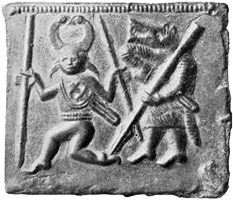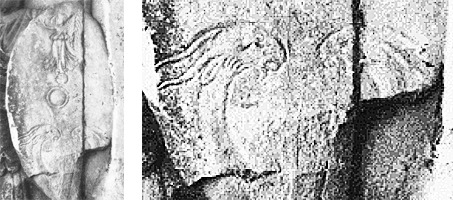
This page created 15 July 2014, and last modified: 22 September 2015 (Rance citation added)

In the western half of the empire, the Exculcatores iuniores Britanniciani is listed (98/9.82 in Ingo Maier's numbering scheme) as one of auxilia palatina units in the Magister Peditum's infantry roster. Its shield pattern (94#16), as shown in various manuscripts under the plain label (94.q) Exculcatores, is as below:

The pattern shows a red rim and a purple main ground (more maroon in P & M and more blue in W, while being inexplicably white in O; Ff is too faded to easily determine the original colour), along with a yellow version of the twin-headed zoomorphic motif that is extremely common in the Notitia (over a dozen examples), especially amongst auxilia palatina: the version borne by the Exculcatores iuniores Britanniciani has a fringed neck, and thus looks very similar to those borne by the Celtae seniores (98/9.37), and in the eastern half of the empire, the Falchovarii (12.33), under the Magister Militum Praesentalis II. This is one of the few patterns for which O gives a version that is different from W in which P rather follows W and not O (here the main ground colour); interestingly, both the patterns previously illustrated are also like this: the Invicti iuniores Britanniciani (98/9.81) and the Batavi iuniores (98/9.81.1).
In addition to its numerous appearances in the Notitia, the twin-headed zoomorphic motif is known from a range of sources in northern Europe, such as on the ca. 6th century Torslunda bronze die from Sweden shown below:

More directly connected with the Roman army is the example depicted on the Arch of Constantine in Rome, completed ca. 315, on a shield carried by a soldier shown participating in the siege of Verona in 312:

A winged Victory stands above the boss, while below, we see two horned creatures, possibly goats, facing each other, and with their necks curving in towards each other (and interpreted by Michael P. Spiedel in "Ancient Germanic Warriors: Warrior styles from Trajan's Column to Icelandic sagas", Routledge, 2004, as dragons).
The name Exculcatores means "those who tread down", and is described in Vegetius' military manual (2.15), roughly contemporary with the Notitia, in these terms: Post hos erant ferentarii et levis armatura, quos nunc exculcatores et armaturas dicimus..., i.e. "Following [the first line] were the ferentarii and [other] light infantry, whom we now call exculcatores and armaturas...". See P. Rance, Latomus 73 (2014), 474-501, available here, for a thorough discussion of the etymology of the word.
Britanniciani naturally means "British", and in the Notitia is used synonymously with Britones, e.g. the Invicti iuniores Britanniciani (98/9.81), a.k.a. the Invicti iuniores Britones (102/5.179). While the name raises the possibility the Exculcatores iuniores Britanniciani was raised in Britain, it is also at least as possible the unit had just just stationed there in the relatively recent past, in which case it might be identified with any of a number of auxiliary units known to have been previously stationed in Britain, and simply renamed.
However, it should be noted that the Exculcatores iuniores Britanniciani, although listed in the Magister Peditum's infantry roster, is apparently not assigned to any of the field commands. This could because the unit has for some reason been omitted or deleted (e.g. because it had been destroyed), or simply missed due to a careless mistake, but it may also be because the unit is actually assigned, but under a somewhat different name. In particular, there is a Victores iuniores Britanniciani assigned (102/5.206) to the the Comes Britanniarum, but no correspondingly named unit in the Magister Peditum's list, which would make a reasonably good fit (Seeck linked the Victores iuniores Britanniciani with the Victores iuniores (98/9.60), a unit of auxilia palatina assigned to the Comes Hispenias, which would seems to raise even more problems than it solves).
Another possibility, however, and more likely, is the Britones listed (102/5.125) in the Magister Equitum's Gallic command, since not only does this unit have a "British" name, it is not listed as such in the infantry roster and thus in need of a match, and its position in the Gallic list comes immediately after that of the Batavi iuniores (Britanniciani) (102/5.124), exactly as it does in the illustrations.
Two other units bear the name Exculcatores in the Notitia: the Exculcatores seniores (98/9.48) and the Exculcatores iuniores(98/9.50). Both are listed in the Magister Peditum's infantry roster as auxilia palatina units, and rather highly ranked at that, but like the Exculcatores iuniores Britanniciani, they are not assigned to any field command. Unlike the Exculcatores iuniores Britanniciani, their shield patterns are not recorded.

Return to the Notitia alphabetical unit list page.
Return to my Notitia index page.